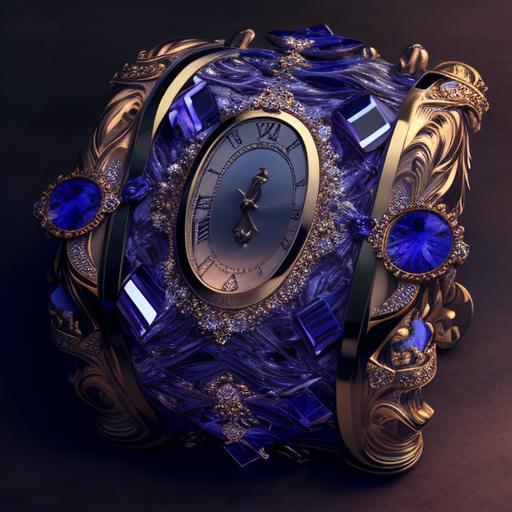


Jewelry and watches are more than mere accessories; they are timeless expressions of personal style, status, and sentiment. Whether you're an avid collector, a fashion enthusiast, or someone looking to make a meaningful purchase, understanding the intricacies of jewelry and watches is essential. This comprehensive guide offers valuable insights and tips for navigating the world of jewelry and watches, helping you make informed choices and curate a collection that reflects your unique taste.
Know Your Style:
Before diving into the world of jewelry and watches, identify your style. Whether you lean towards classic, modern, vintage, or eclectic aesthetics, understanding your preferences streamlines your choices and ensures that your selections align with your overall look.
Understand Metals and Materials:
Familiarize yourself with different metals and materials used in jewelry. From the timeless elegance of gold and silver to contemporary materials like titanium and stainless steel, each metal carries its unique characteristics. Consider factors such as durability, hypoallergenic properties, and maintenance requirements when making choices.
Quality Over Quantity:
When building a jewelry collection, prioritize quality over quantity. Investing in well-crafted pieces, even if they are fewer in number, ensures longevity and enduring style. Quality jewelry and watches often become heirlooms, passed down through generations.
Educate Yourself on Gemstones:
For gemstone enthusiasts, understanding the properties and characteristics of different stones is essential. Whether it's the vivid hues of rubies and sapphires or the brilliance of diamonds, knowing about gemstones enhances your appreciation and guides your purchasing decisions.
Consider Jewelry and Watch Maintenance:
Regular maintenance is crucial for preserving the beauty and functionality of jewelry and watches. Clean your pieces regularly, store them in appropriate conditions, and schedule professional inspections to address any issues promptly. Proper care extends the life of your cherished items.
Mix and Match:
Experiment with mixing and matching jewelry and watches to create unique combinations. Pair classic pieces with more contemporary designs or layer delicate necklaces for a trendy look. Mixing styles and textures add depth and personality to your ensemble.
Customization and Personalization:
Many jewelers offer customization options, allowing you to create one-of-a-kind pieces. Consider engraving initials, adding birthstones, or incorporating meaningful symbols to make your jewelry and watches truly unique and reflective of your story.
Stay Informed on Trends:
While timeless pieces are the backbone of any collection, staying informed on current trends allows you to infuse fresh elements into your style. Follow fashion magazines, blogs, and social media to discover emerging trends in jewelry and watches.
Invest in Versatile Pieces:
Choose versatile pieces that can seamlessly transition from casual to formal settings. A pair of classic diamond studs, a timeless watch, or a simple gold bracelet are examples of versatile items that complement a variety of outfits and occasions.
Authenticate Your Purchases:
When investing in high-value items, such as vintage watches or fine jewelry, ensure authenticity. Purchase from reputable dealers, request certificates of authenticity and familiarize yourself with the specific markings and characteristics that distinguish genuine pieces from replicas.
Budget Wisely:
Establish a budget for your jewelry and watch purchases and adhere to it. Consider the long-term value and significance of each item rather than succumbing to impulse buys. A well-thought-out collection is built over time with mindful choices.
Explore Sustainable and Ethical Options:
As awareness of ethical sourcing and sustainability grows, consider exploring jewelry and watch brands that prioritize responsible practices. Many companies now offer products made from recycled materials or ethically sourced gemstones, contributing to a more conscious and eco-friendly industry.
Jewelry is a decorative item that is worn on the body, typically made from precious metals, gemstones, or other valuable materials. Jewelry can take many forms, from simple earrings or necklaces to elaborate tiaras or brooches. Here are some common types of jewelry:
Rings: Circular bands worn on the finger, often used to symbolize love, commitment, or achievement. Rings can be made from gold, silver, platinum, or other metals, and may include gemstones or other decorative elements.
Necklaces: Decorative chains or cords worn around the neck, often featuring pendants or other hanging elements. Necklaces can be made from a wide variety of materials, including gold, silver, pearls, and beads.
Earrings: Decorative items are worn on or around the earlobe, often featuring precious metals, gemstones, or other decorative elements.
Bracelets: Decorative bands worn around the wrist, often featuring precious metals, gemstones, or other decorative elements.
Brooches: Decorative pins or clips worn on clothing, often featuring intricate designs or precious materials.
Watches: Timepieces worn on the wrist or carried in a pocket. Watches can be purely functional or can also serve as a decorative accessories, with designs that range from simple and minimalist to ornate and elaborate.
Anklets: Decorative chains or cords worn around the ankle, often featuring beads or other hanging elements.
Body jewelry: Jewelry worn in piercings or other body modifications, such as nose rings, belly button rings, or eyebrow rings.
(!) Other types include cufflinks, tie pins, hair ornaments, and more.
The most expensive types of jewelry are typically those that feature rare and precious gemstones, as well as those that are made from precious metals such as gold or platinum. Here are some examples:
Diamonds: Diamonds are among the most valuable and sought-after gemstones in the world, and diamond jewelry is often some of the most expensive. The value of a diamond is determined by a variety of factors, including its size, clarity, and color.
Colored gemstones: Other rare and valuable gemstones include emeralds, rubies, and sapphires. These stones can command high prices when they are of exceptional quality and are often used in high-end jewelry designs.
Gold: Gold is a precious metal that has been used in jewelry-making for centuries. It is valued for its rarity and beauty and is often used in the construction of high-end jewelry designs.
Platinum: Platinum is another precious metal that is highly valued in the jewelry industry. It is more rare than gold and is often used in the construction of high-end watches, wedding bands, and other types of jewelry.
Designer jewelry: Some jewelry pieces are considered valuable because of their designer or brand name. Jewelry from top luxury brands like Cartier, Tiffany & Co., and Harry Winston can command high prices due to their reputation and exclusivity.
(!) The materials and design of the jewelry, other factors that can impact its value include its rarity, historical significance, and provenance. Pieces that have a unique story or that have been owned by famous individuals can also command high prices at auction or in the collector's market.
Watches come in many different types, styles, and functions. Here are some of the most common types of watches:
Analog Watches: Analog watches are the traditional type of watch that use a small hand to indicate the hours, minutes, and sometimes seconds. The dial of an analog watch may also feature numbers, markers, or other indicators to help the wearer tell time.
Digital Watches: Digital watches display the time using digital numbers rather than hands or markers. They often have additional features like alarms, timers, and stopwatch functions.
Dress Watches: Dress watches are typically simple and understated, designed to complement formal attire. They often have a thin case and a leather strap and may feature a minimalist design.
Sports Watches: Sports watches are designed to be durable and functional, often featuring features like water resistance, shock resistance, and stopwatch functions. They may also have additional features like GPS, heart rate monitors, and other fitness-tracking capabilities.
Smart Watches: Smartwatches are digital watches that are designed to integrate with smartphones and other devices. They typically have a variety of features like notifications, fitness tracking, GPS, and the ability to make and receive phone calls and text messages.
Chronograph Watches: Chronograph watches have a stopwatch function built into them, allowing the wearer to time events or activities with precision. They often have multiple sub-dials and buttons to control the stopwatch function.
Automatic Watches: Automatic watches are self-winding watches that do not require a battery or manual winding. They are powered by the movement of the wearer's wrist, which winds a small rotor inside the watch.
Jewelry and watches are often connected because they are both accessories that are worn to enhance a person's style and appearance. Many watches are considered a type of jewelry, especially those that are made from precious metals like gold or platinum, and those that feature diamonds or other gemstones.
Many high-end jewelry brands also produce luxury watches, often incorporating their signature design elements into the watch's design. For example, Cartier is a famous jewelry brand that also produces high-end watches with a distinctive style that is recognizable to many people.
Some people also consider watch bands or straps to be a type of jewelry, as they can be made from materials like leather, metal, or even precious metals and can add an extra level of style and sophistication to a watch.
Jewelry and watches are not just adornments; they are expressions of individuality and milestones in one's journey. By incorporating these tips into your approach to jewelry and watches, you can curate a collection that tells your story, stands the test of time, and becomes a source of joy and sentiment. Embrace the elegance, explore your style, and let your jewelry and watches become enduring symbols of your unique identity.
Have a good one,

We use cookies
We use cookies and other tracking technologies to improve your browsing experience on our website, to show you personalized content and targeted ads, to analyze our website traffic, and to understand where our visitors are coming from. Privacy Policy.